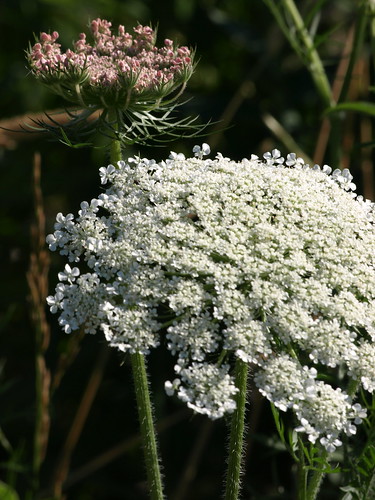Thistle, prickly to the hand and quite noxious to other plants as it tends to take over and monopolize the land to the detriment of other plants. The name “thistle” is an Anglo-Saxon word meaning “to stab” – the plant is appropriately named, full of thorn set as a defense against crawling creatures after the flowers’ extremely sweet nectar. Birds and butterflies can easily approach though, and goldfinches are especially fond of both the seed as food and the down as nesting material.
Butterfly Weed, as the name implies, is an irresistible plant for butterflies. The huge domes make lovely landing pads and dining palaces for many adult butterflies and the foliage feeds the larvae of the monarchs. It is the orange member of the milkweed family.
Queen Anne’s Lace, also called Wild Carrot. Its leaves, stem and root taste and smell like the garden carrot, its taproot can be eaten as a vegetable or roasted as a “coffee”. And legend says that if the “flowers of the lace are mixed in sweet red wine and drunk long into the evening” it acts not only as a love potion, but also as a contraceptive. Can’t speak for or against that lore.
The Common Milkweed might as well be called the Monarch Butterfly Plant, as it is essential to all stages of that butterfly’s existence. They lay their eggs on the plant; the caterpillars spend their entire lives feeding on the leaves. Once mature, they build their chrysalises on the undersides of the leaves, and when the butterflies emerge from their cocoons, they feed on the flowers. The plant also provides protection to the Monarchs as the sap the caterpillars feed on is distasteful and keeps away predatory birds.










